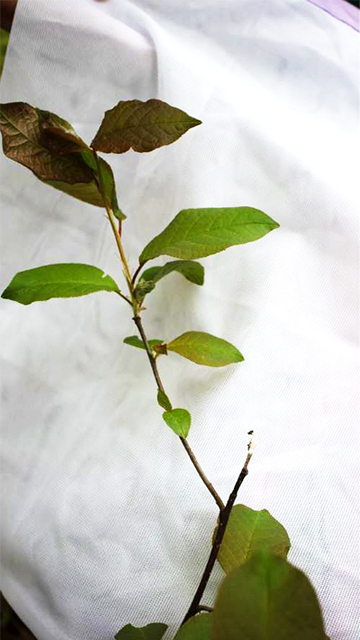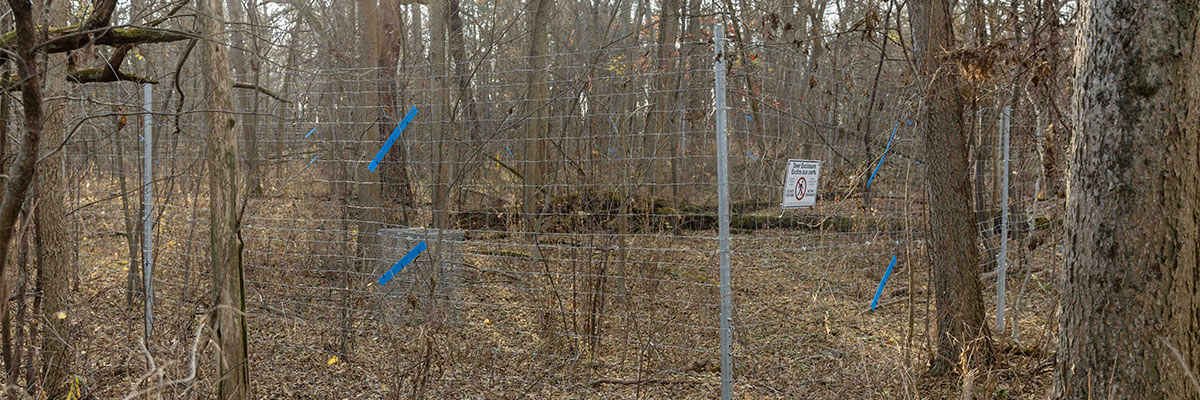
Vegetation Monitoring and White-Tailed Deer
Point Pelee National Park
Point Pelee National Park conducts several different vegetation monitoring programs each year. Of these, two programs – seedling regeneration and browse monitoring – are a small part of the monitoring that supports the Hyperabundant Deer Management Program. The Hyperabundant Deer Management Program, in partnership with Caldwell First Nation, includes ecosystem monitoring, deer population monitoring, species-at-risk protection, and ongoing research and collaboration, in addition to reducing the deer population to sustainable levels to support ecosystem health.
Both seedling regeneration and deer browse monitoring focus on assessing smaller vegetation, which allows park staff to not only examine the current health of the forest, but also to predict forest health into the future.
Seedling Regeneration
Point Pelee has been monitoring seedling regeneration consistently since 2012, using the Ecological Monitoring & Assessment Network (EMAN) protocol. There are 20 monitoring plots set up throughout the park (each 20 m x 20 m), and each plot contains 5 subplots (each 2 m x 2 m). Each plot is monitored at around the same time (mid-July to mid-August), every other year.
Within each subplot, park staff count all seedlings and saplings of species that have the potential to grow to tree size. Staff then calculate the average seedling density within the subplots, to understand any differences in density over time, and to use that information to get a sense of the health of the forest. Studies in forests similar to Point Pelee’s provide an estimate of what the average seedling density should be for a healthy forest. Currently, Point Pelee’s seedling regeneration is in poor condition. Many studies have shown that overbrowsing by deer can cause seedling density to decrease significantly, and that it can take many years for seedling density to increase, even once browsing pressure is reduced.
Deer Browse

Past deer browse studies in Point Pelee National Park have shown that white-tailed deer browsing has a negative impact on forest health. Because deer tend to browse certain species more than others, overly large or hyperabundant deer populations have the potential to change the species composition and diversity of the forest over time. Unchecked deer browsing could result in certain species being lost from the park altogether, especially if those species are already rare and/or grow in smaller clumps. For example, it is likely that Canada yew (Taxus canadensis) disappeared from the park due to deer overbrowsing. Efforts to increase populations of rare plants could also be jeopardized by deer.
Given these considerable effects, it is important to have a good understanding of what deer browse looks like in the park, which is why browse data collection was added to vegetation monitoring work in 2022. Deer browse monitoring happens in the same subplots as seedling regeneration monitoring. For each seedling or sapling found in a subplot (including shrubs that don’t grow to tree height), park staff record whether it was browsed within the last year or not, and – if it was browsed – whether the browse was done by deer or by rabbits. Knowledge provided by Caldwell First Nation has been very important in implementing these monitoring techniques. Point Pelee National Park is committed to refining the monitoring program as needed, as we continue to learn about deer browse in the park.
Deer Exclosures

In 2022, five exclosures were set up throughout the park, in different forested locations close to existing monitoring plots. Exclosures are sturdy, fenced-in areas that exclude or keep certain species out, so that researchers can monitor how the vegetation inside the exclosure responds with the absence of those species.
Seedling regeneration and browse subplots inside exclosure areas were set up and monitored in the summer of 2022, before fencing was installed, to gather baseline data (see text box). Since the exclosures are close to existing non-fenced monitoring plots, park staff will be able to compare and measure the differences in growth rates and browse between plants inside the exclosures and plants outside of the exclosures. The results of this monitoring will help answer questions such as:
What is Baseline Data?
Baseline data is information that is collected before something happens. This baseline data can be compared to information collected after something happens, to give researchers a better idea of whether there were changes.
- Are seedling regeneration and/or browse impacts different inside the exclosures?
- Does seedling regeneration improve and/or deer browse impacts lessen as the deer population is reduced?
- Are there certain species within the park that are preferred by browsing deer?
The seedling regeneration and deer browse vegetation monitoring programs are key parts of Point Pelee National Park’s commitment to managing vegetation and wildlife adaptively and responsibly.
Related links
- Date modified :